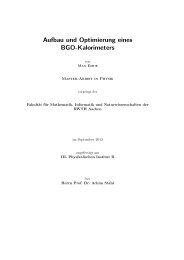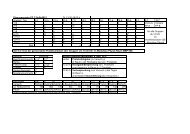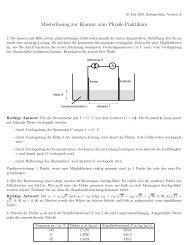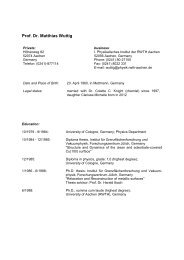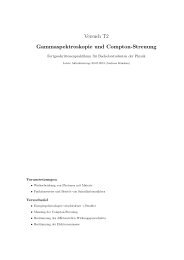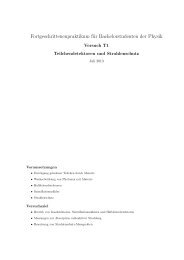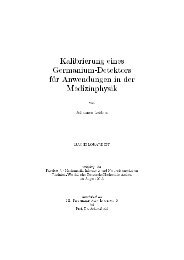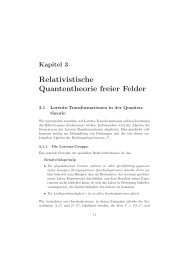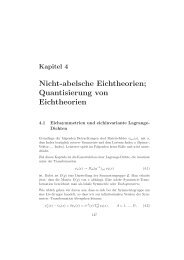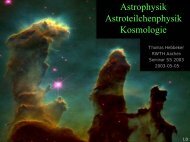Model Independent Search for Deviations from the Standard Model ...
Model Independent Search for Deviations from the Standard Model ...
Model Independent Search for Deviations from the Standard Model ...
You also want an ePaper? Increase the reach of your titles
YUMPU automatically turns print PDFs into web optimized ePapers that Google loves.
20 Tevatron and <strong>the</strong> DØ-Detector<br />
Figure 2.5: On <strong>the</strong> left picture <strong>the</strong> open detector is shown during <strong>the</strong> installation of <strong>the</strong> Inner<br />
Tracker. On <strong>the</strong> right an exterior view can be seen with <strong>the</strong> scintillation counters of<br />
<strong>the</strong> Muon System building <strong>the</strong> outer shell [6].<br />
As a consequence this analysis uses only muon momentum in<strong>for</strong>mation measured with <strong>the</strong><br />
tracker.<br />
The tracker itself consists of two layers: The Silicon Vertex Detector SMT being <strong>the</strong><br />
closest to <strong>the</strong> nominal vertex and <strong>the</strong> Scintillating Fiber Tracker CFT, both displayed in<br />
Figure 2.6. The SMT is <strong>the</strong> high resolution part of <strong>the</strong> tracking system, enabling secondary<br />
vertex measurement, which is important <strong>for</strong> B-physics and identifying b-jets. Since<br />
<strong>the</strong> collider interaction point is extended in z with σ z ≈ 25 cm, a combination of barrel<br />
detectors measuring <strong>the</strong> coordinates r − ϕ and disk detectors measuring r − z and r − ϕ<br />
was chosen. Because of <strong>the</strong>se disk detectors, even particles with large pseudorapidities<br />
can have SMT- hits, thus a specic η-coverage is dependent on <strong>the</strong> amount of required<br />
SMT-hits. The barrel detectors consist of 4 layers of 50 and 60.5 µm silicon strips, most of<br />
<strong>the</strong> layers consisting of double-sided detectors <strong>for</strong> two-coordinate in<strong>for</strong>mation. Each layer<br />
is divided into six segments, 12 cm per segment. All six segments are sealed o by one of<br />
<strong>the</strong> 12 double sided F disks and <strong>the</strong> six remaining disks are located at each side next to<br />
<strong>the</strong> barrel. Four large diameter single-sided H disks enclose <strong>the</strong> SMT at |z| = 110 cm<br />
and |z| = 120 cm, covering <strong>the</strong> very <strong>for</strong>ward η-region.<br />
To enhance tracking eciency, <strong>the</strong> CFT, covering <strong>the</strong> range |η| < 1.62 (with in principle 16<br />
measurement points available), is <strong>the</strong> second component of <strong>the</strong> tracker. This yields more<br />
hits available <strong>for</strong> <strong>the</strong> track reconstruction. The CFT consists of 74, 000 scintillating bers<br />
mounted on eight concentric cylinders at radii <strong>from</strong> 19.5 to 51.5 cm surrounding <strong>the</strong> silicon<br />
vertex detector. The cylinders support a doublet layer of bers and four having a doublet<br />
at stereo angles <strong>for</strong> in<strong>for</strong>mation on z-coordinates. These bers consist of three materials<br />
increasing light trapping and mechanical robustness. The scintillated light is guided by<br />
11 m long ber waveguides to Visible Light Photon Counters, cryogenic photomultipliers<br />
with a quantum eciency of ∼ 70% capable of detecting single photons.




